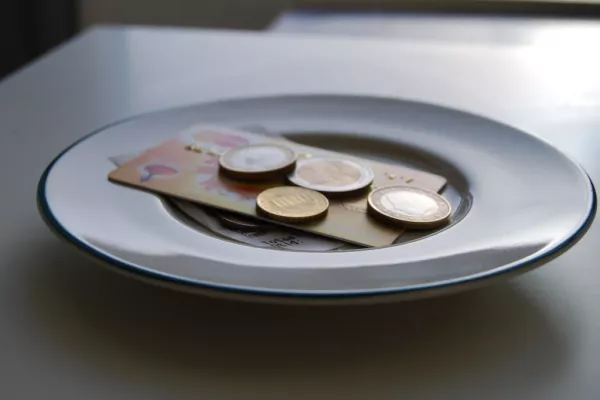When a diner makes a reservation at Fedora, Gabriel Stulman’s speakeasy-inspired basement restaurant in Manhattan’s West Village, the confirmation e-mail warns customers to skip the tip.
The reservation system repeats the no-gratuity reminder with a text message that arrives 30 minutes before each seating. Guests arriving at Fedora will also hear an explanation from the maître d’ about the recently increased menu prices, which have been put in place so Stulman can pay higher wages. When the check comes, it’s paper-clipped to a postcard printed with two key words: gratuity free.
Does that sound like overkill? Tipping at US restaurants has been an ironclad social convention for two centuries, creating a weighty burden for the restaurateurs leading the way into the gratuity-free future. Diners know to pay two distinct sums: one to the establishment for food, another to the waitstaff for service. Stulman is part of a small vanguard trying to overturn restaurant economics by consolidating those two payments, a move he says will allow him to better pay better kitchen workers.
But changing consumer behavior is complicated stuff, and so is overcoming the menu math. An entree priced at $24 in a restaurant reliant on tipping might show up on the menu for $30, once service is included. "I don’t want anyone to think we just jacked up all of our prices," said Stulman, who plans to get rid of tipping at his five other Manhattan restaurants—if the new policy at Fedora works. "We're not going to force-feed something down guests' throats if they don’t believe in it."
The no-tipping movement has attracted broad support from a diverse set of food-world players, including Top Chef's Tom Colicchio and the executive suite at Ignite Restaurants Group, which owns the Joe's Crab Shack chain. Saru Jayaraman, co-director at Restaurant Opportunities Centers United, a labor-advocacy group, sees the service-included system as a pathway to fairer wages for restaurant workers, a group that includes one in 11 private sector workers in the US. Few work at hip Manhattan restaurants.
There's a lot riding on early adopters. As more diners become familiar with the model, it will be easier for more restaurants to take the plunge. A few high-profile failures, on the other hand, could convince the industry not to mess with the status quo.
In addition to patience, resolve, and over-communication, Andrew Tarlow believes the no-tipping movement needs better branding.
When Tarlow, whose restaurants include Williamsburg mainstays Diner and Marlow and Sons, decided to experiment with a no-tipping policy, he commissioned a graphic designer to create a symbol for the new system. The designer, Drew Heffron, came back with the phrase “gratuity free” as an alternative to such negative constructions as “no tip.” It continues the verbal lineage of common restaurant phrases such as smoke-free or gluten-free while the design plays on the percentage sign, replacing one of the circles with an "X."
Tarlow hung the symbol in the front window at Roman’s, his Italian restaurant in Brooklyn's Fort Greene neighbourhood, which did away with tips last month. Fedora's Stulman also adopted the symbol. "A non-proprietary logo that diners could see across the city would simplify things tremendously," Tarlow said. "We process visual information quickly."
Diners evaluate restaurant expensiveness according only to menu prices, said Michael Lynn, a professor at the Cornell University School of Hotel Administration who studies tipping. This means that a couple sitting down at a favorite restaurant might have a typical amount in mind to spend—let's say $80 for food and drinks—and that figure won't include the tip. Bundling the fee for the waitstaff into the single menu price messes with the perceived expensiveness of the meal.
Restaurants without tipping probably need to increase menu prices by about 25 per cent, according to Anthony Rudolf, founder of Journee, a New York-based outfit that trains restaurant professionals. In other words, that couple accustomed to ordering $80 of food and drink must now be convinced to feel the same way about spending $100. Rudolf has held open meetings for restaurant operators interested in abolishing tips, and more than 100 people have turned up for each session. "Everyone wants to know how to do this," he said. "What's the new menu price? How do I talk about it? There's no silver bullet."
The complexities of the switch extend beyond the front of house. Restaurants pass tip revenue through to employees without paying sales tax. Adding 20 percent to house receipts means paying more in taxes and sometimes even higher rent because some restaurants have revenue-sharing agreements in their leases. Simply experimenting with a service-included model can bring a long-simmering tension to a boil by acknowledging that tipping has long favored waiters and bartenders over line cooks and shift managers.
The general public is often misinformed about how the tipping economy works, adding another wrinkle to any transition. When Union Square Hospitality Group began switching over to service-included pricing at its 13 New York restaurants, Chief Executive Officer Danny Meyer hosted a series of town halls to respond to feedback from diners. The company learned that diners typically overestimate their ability to reward or punish their waiter, said Sabato Sagaria, chief restaurant officer for the company. Most diners didn't know that tips are pooled and divided among certain workers. Labor law, however, restricts kitchen workers from sharing in tips. "Anytime we give a raise to the back of house, prices go up to compensate," Sagaria said. "Tips also go up, [feeding] the disparity."
Meyer is hosting another town hall on Tuesday night to answer questions before shifting to a service-included model at Manhattan trattoria Maialino on Feb. 25. Over time, Sagaria expects customers to get better at interpreting tip-free prices, an experience he likens to calculating prices listed in a foreign currency. At the Modern, a Union Square Hospitality restaurant that has dropped tipping, the policy has pushed some customers toward cheaper wine choices. So far, however, guests are spending enough on food to validate the policy. "We held our breath and flipped the switch," Sagaria said. "Fortunately, we didn’t see much movement."
Article by Bloomberg, edited by Hospitality Ireland









